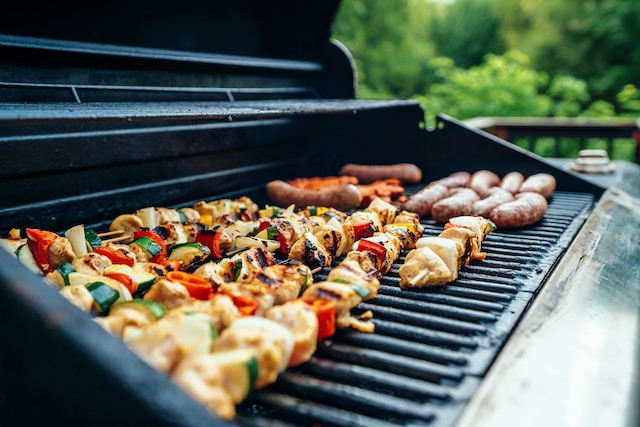
In the vast melting pot that is American cuisine, diversity and creativity reign supreme. From coast to coast, the culinary traditions of the United States vary greatly, influenced by the waves of immigrants who have arrived on its shores over the centuries. As a result, American cuisine has become a mosaic of flavors, techniques, and ingredients from around the world.
One of the most beloved culinary traditions in America is the art of barbecue and grilling. Whether you’re in the South, the Midwest, or the West Coast, you’ll find that barbecue and grilling are deeply ingrained in American culture. These food traditions have become an integral part of American cuisine, and they continue to be celebrated year-round, especially during the warm months of summer.
Barbecue and grilling have a long and storied history in America, dating back to the Native American tribes who used the technique to cook game meat over open fires. Over time, the technique was refined and perfected by African-American and Latino communities, who infused their own unique flavors and spices to the mix. And as the tradition spread, it also evolved to include various regional styles, from the smoky, sweet flavors of Memphis to the tangy, vinegar-based sauces of North Carolina.
People should not forget the importance of seasoning to the grilling process. If you forget to add the right amount of spices, salt, pepper, etc, to a dish, it will come out bland and tasteless.
Today, barbecue and grilling represent more than just a way to cook food; it’s a way of life for millions of Americans. It’s a reason to gather with friends and family, a chance to bond over a shared love of food, and a chance to showcase your skills as a pitmaster. Whether you’re grilling up burgers in the backyard, smoking brisket on a drum smoker, or slow-cooking a whole hog in a pit, barbecue and grilling are the quintessential American culinary experience.
Grilling Techniques and Equipment
Grilling is an art that can be enjoyed by anyone, regardless of experience. With the right equipment and some basic techniques, anyone can transform a piece of meat, poultry, or fish into a mouth-watering delicacy. Here are some grilling techniques and equipment that you can use to take your grilling game to the next level.
Grilling Techniques
Direct Grilling: This technique involves cooking food directly over the heat source. This technique is best for thin cuts of meat, such as chicken breasts, steaks, or hamburgers. The heat sears the surface of the food, giving it that classic grilled flavor.
Indirect Grilling: This technique involves cooking food away from the direct heat source. This is best for larger cuts of meat, such as a whole chicken or pork roast. The food is cooked slowly and evenly, giving it a tender and juicy texture.
Smoking: This technique involves cooking food with smoke, often from wood chips or pellets. This technique is best for tougher cuts of meat, such as brisket or ribs. The smoke infuses the food with flavor and helps to break down the tough fibers, resulting in a tender and succulent texture.
Equipment
Charcoal Grill: A classic and affordable option to get started with grilling. Charcoal grills provide the most authentic flavor and are great for slow-cooking meats.
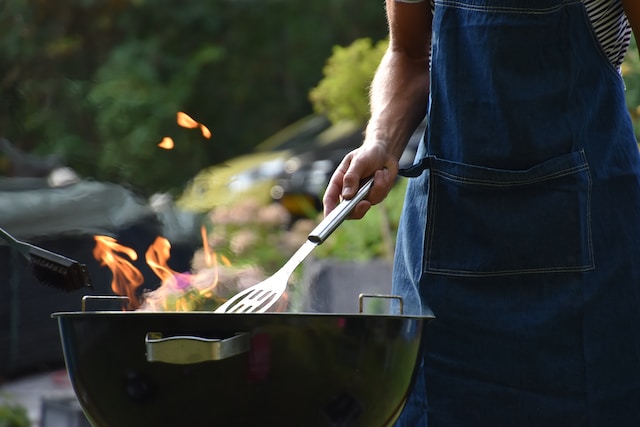
Gas Grill: A faster and easier option that allows for temperature control. Gas grills are perfect for cooking vegetables and seafood.
Pellet Grill: A relatively new option that uses wood pellets as fuel. The pellets produce a consistent level of smoke, resulting in a smoky flavor. Pellet grills are great for smoking and slow-cooking.
Drum Smoker: A vertical smoker made from a steel drum. The heat source is at the bottom, and the food is hung from racks above. Drum smokers are great for smoking large cuts of meat, such as pork shoulder or brisket.
Accessories
Thermometer: A must-have accessory for grilling. A thermometer ensures that the food is cooked to the right temperature, avoiding undercooked or overcooked food.
Grill Brush: A brush to clean the grill grates before and after cooking. Clean grates ensure that the food is freed from any remnants of the old foods and that they are ready to cook.
Grilling Basket: A basket that helps to cook smaller items, such as vegetables or seafood, without them falling through the grates.
Grill Cover: A cover to keep your grill clean, dry, and protected from the elements.
These are just a few of the many grilling techniques and equipment that you can use to take your grilling game to the next level. With a little practice and experimentation, you’ll be able to create some delicious grilled meals that your family and friends will love.
Regional Barbecue Styles
When it comes to barbecue, every region in the United States has its own unique style, sauce, and technique. Here’s a breakdown of some of the most popular regional barbecue styles:
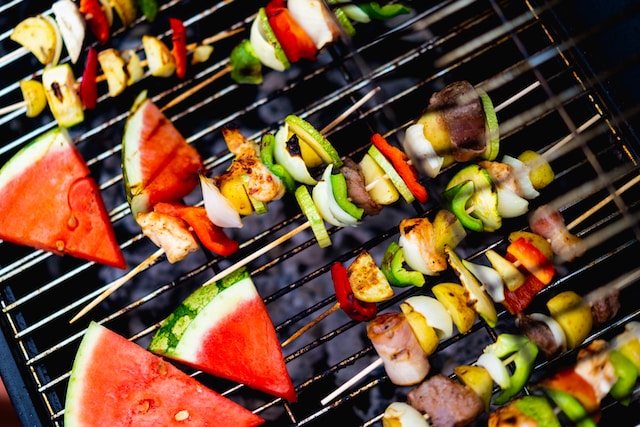
Memphis Style Barbecue
Memphis is known for its dry-rubbed, slow-cooked meat, especially pork ribs and shoulder. The rub is made from a blend of spices that includes paprika, garlic, onion, and chili powder. Memphis-style barbecue is also known for its sweet and tangy tomato-based BBQ sauce that is typically served on the side.
Carolina Style Barbecue
There are two main styles of Carolina barbecue: Lexington-style (Western) and Eastern-style. Both styles use vinegar-based sauce, but Eastern-style adds some red pepper flakes for extra heat. Carolina-style barbecue also features pork shoulder as the meat of choice and is typically cooked over wood rather than charcoal or gas.
Texas Style Barbecue
Texas-style barbecue is all about beef, specifically brisket. The meat is dry-rubbed and slow-cooked over wood for up to 16 hours, resulting in a smoky and tender texture. Texas barbecue sauce is typically served on the side and is a mix of tomato, chili powder, and Worcestershire sauce.
Kansas City Style Barbecue
Kansas City-style barbecue is known for its thick and sweet sauce, which is a blend of tomato, molasses, and brown sugar. The meat of choice is typically pork ribs or beef brisket, and it is usually slow-cooked over hickory wood. Kansas City-style barbecue also features a side of baked beans and coleslaw.
Alabama Style Barbecue
Alabama-style barbecue is all about pulled pork, and the sauce is typically a white barbecue sauce made from mayonnaise, vinegar, and spices. The meat is slow-cooked over hickory wood, and the white barbecue sauce is served on the side.
Hawaii Style Barbecue
Hawaiian-style barbecue, also known as “Huli-Huli”, features a sweet and tangy marinade made from soy sauce, brown sugar, ginger, and garlic. The meat of choice is typically chicken or pork, and it is grilled over an open flame. Pineapple is often used in Hawaiian-style barbecue as a garnish or marinade.
St. Louis Style Barbecue
St. Louis-style barbecue is known for its focus on pork ribs. The ribs are typically trimmed to a rectangle shape, and the sauce is a blend of tomato, vinegar, and molasses. St. Louis-style barbecue also features side dishes like baked beans and potato salad.
Popular Barbecue and Grilling Recipes
Barbecue and grilling are versatile techniques that can be used to cook a wide variety of meats, poultry, fish, and vegetables. Here are some popular recipes that you can try the next time you fire up the grill.
Recipe: Classic Burger

Ingredients:
- 1 pound of ground beef
- 1 onion (finely chopped)
- 1 egg
- 1/2 cup breadcrumbs
- Salt and pepper
Instructions:
- In a large mixing bowl, combine the ground beef, chopped onion, egg, breadcrumbs, salt, and pepper.
- Mix well until all the ingredients are evenly distributed.
- Divide the mixture into four equal balls and flatten them into patties.
- Preheat your grill to medium-high heat and grease the grates.
- Place the burgers on the grill and cook for 3-4 minutes on each side or until they reach the desired temperature.
- Serve on a bun with your favorite toppings, such as cheese, lettuce, tomato, and ketchup.
Recipe: Baby Back Ribs
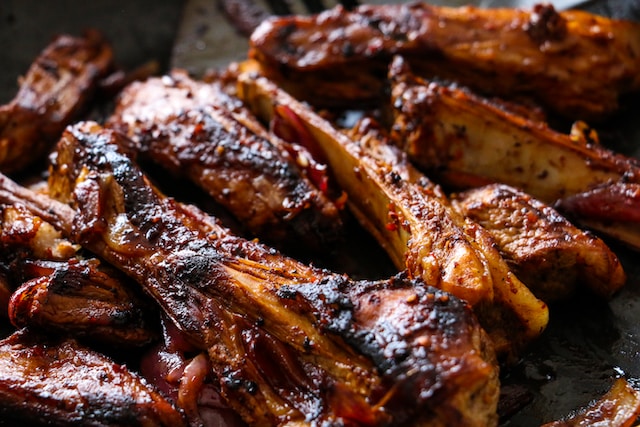
Ingredients:
- 2 racks of baby back ribs
- 1 tablespoon of salt
- 1 teaspoon of black pepper
- 1 teaspoon of paprika
- 1/2 teaspoon of garlic powder
- 1/2 cup of BBQ sauce
Instructions:
- Preheat your grill to low heat.
- Mix together the salt, pepper, paprika, and garlic powder in a small bowl.
- Rub the spice mixture onto the ribs, making sure to coat both sides evenly.
- Wrap the ribs tightly in aluminum foil and place them on the grill.
- Cook for 2-3 hours or until the meat is tender and falls off the bone.
- Remove the foil and brush the BBQ sauce onto the ribs.
- Increase the heat to medium-high and grill the ribs for an additional 5-10 minutes or until the sauce is caramelized.
Recipe: Grilled Chicken

Ingredients:
- 4 chicken breasts
- 2 tablespoons of olive oil
- 2 cloves of garlic (minced)
- 1 lemon (juiced)
- 1 tablespoon of honey
- 1 teaspoon of smoked paprika
- Salt and pepper
Instructions:
- In a small mixing bowl, whisk together the olive oil, garlic, lemon juice, honey, smoked paprika, salt, and pepper.
- Place the chicken breasts in a large resealable plastic bag and pour the marinade over them.
- Seal the bag and gently shake to coat the chicken evenly.
- Marinate the chicken in the refrigerator for at least 2 hours or up to overnight.
- Preheat your grill to medium-high heat and grease the grates.
- Remove the chicken from the marinade and discard the bag and excess marinade.
- Place the chicken on the grill and cook for 6-8 minutes on each side or until the internal temperature reaches 165°F.
Recipe: Grilled Vegetables
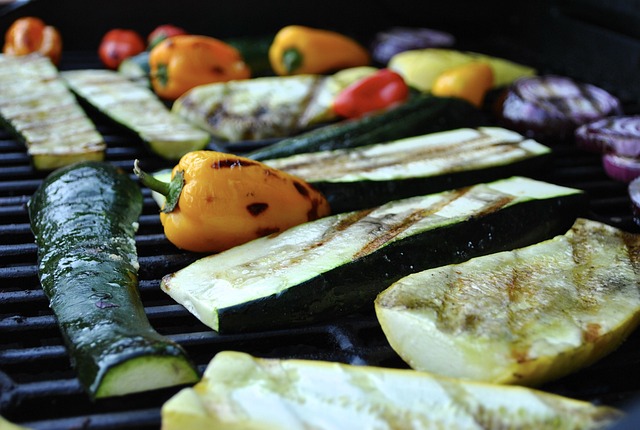
Ingredients:
- 1 red bell pepper (sliced)
- 1 yellow squash (sliced)
- 1 zucchini (sliced)
- 1 red onion (sliced)
- 2 tablespoons of olive oil
- 1 teaspoon of salt
- 1/2 teaspoon of black pepper
- 1/2 teaspoon of dried oregano
- 1 tablespoon of balsamic vinegar
Instructions:
- Preheat your grill to medium-high heat.
- In a large mixing bowl, toss together the sliced red bell pepper, yellow squash, zucchini, and red onion with olive oil, salt, pepper, and dried oregano.
- Place the vegetables on the grill and cook for 3-5 minutes on each side or until they are slightly charred and tender.
- Transfer the grilled vegetables to a serving dish and drizzle with balsamic vinegar before serving.
These are just a few examples of popular barbecue and grilling recipes. With a little creativity and experimentation, you can create your own unique versions of these classic dishes. Remember to always follow safe grilling practices and to use a meat thermometer to ensure that your food is cooked to the appropriate temperature.
Barbecue Sides and Accompaniments
Barbecue and grilling are not just about the meat. The sides and accompaniments are just as important in creating a well-rounded and satisfying meal. Here are some classic barbecue side dishes to try:
Coleslaw – This refreshing side dish is made with thinly sliced cabbage, carrots, and onions combined with a tangy dressing of mayonnaise, vinegar, and sugar. It’s a great contrast to rich and smoky meats, and it’s perfect for summertime cookouts.
Baked Beans – A staple in many barbecue joints, baked beans are a sweet and savory side dish made with navy beans, molasses, brown sugar, and bacon. It’s an easy make-ahead side dish that’s perfect for feeding a crowd.
Potato Salad – Whether it’s made with classic mustard, mayonnaise, or vinegar-based dressing, potato salad is a barbecue favorite. It’s a hearty side dish that’s perfect for balancing out the richness of meats.
Mac and Cheese – This creamy and cheesy comfort food is a staple in many Southern kitchens. It’s a great side dish for barbecue and grilling, especially for picky eaters.
Cornbread – A classic Southern side dish made with cornmeal, flour, sugar, and buttermilk. It’s a sweet and savory treat that’s perfect for sopping up barbecue sauce.
Grilled Vegetables – Grilled vegetables are a healthy and delicious side dish to complement meats. Try grilling bell peppers, zucchini, onions, or mushrooms with a drizzle of olive oil and a sprinkle of salt and pepper.
Corn on the Cob – Sweet and juicy corn on the cob is a summertime staple. It’s a simple side dish that’s perfect for grilling alongside meats. Add a pat of butter and a sprinkle of salt for a classic flavor.
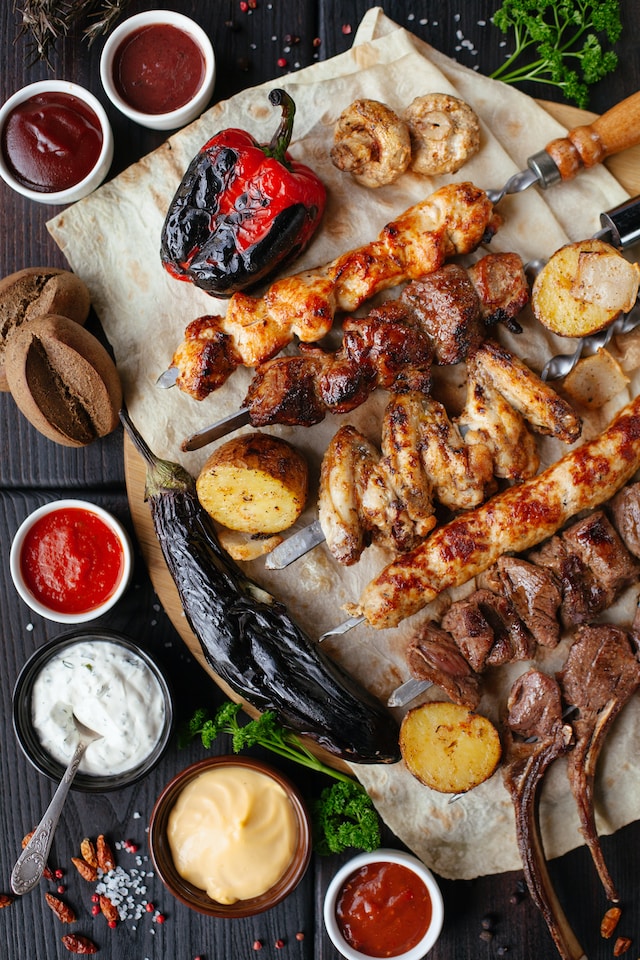
Deviled Eggs – This classic appetizer is a great addition to any barbecue spread. Hard-boiled eggs are filled with a mixture of mayonnaise, mustard, and spices for a creamy and tangy treat.
Collard Greens – This Southern favorite is a hearty and flavorful side dish made with collard greens, smoked ham hocks, and spices. It’s a great way to balance out rich and smoky meats.
Watermelon Salad – A light and refreshing side dish made with juicy watermelon, feta cheese, mint, and a drizzle of balsamic vinegar. It’s a great contrast to heavier barbecue dishes.
When it comes to barbecue sides and accompaniments, there are endless possibilities. These classic dishes are a great starting point, but don’t be afraid to experiment and try new things. With a little creativity, you can create a well-rounded and satisfying barbecue menu.
Barbecue Techniques for Home Cooks
Barbecue and grilling can seem intimidating to some home cooks, but with a little practice and some tips and tricks, anyone can become a master of the grill. Here are some techniques to help you up your barbecue game.
Preparing the meat
When it comes to barbecue, the quality of the meat is key. Start with high-quality cuts of meat and prepare them properly. Here are some tips:
- Remove excess fat: Trimming excess fat from the meat will help prevent flare-ups and ensure that the meat cooks evenly.
- Brine or rub: Brining or rubbing meat with a dry spice mixture can add flavor and help to tenderize tougher cuts of meat.
- Allow the meat to come to room temperature before cooking: This will help the meat cook more evenly and prevent it from drying out.
Using the right equipment
The right tools can make a big difference in the quality of your barbecue. Here are some essentials to have on hand:
- A high-quality grill: Whether you prefer charcoal, gas, or pellet, invest in a grill that fits your needs and budget.
- A meat thermometer: This will help ensure that your meat is cooked to the appropriate temperature and reduces the risk of undercooking or overcooking.
- Tongs: A good pair of tongs will make it easier to handle the meat on the grill.
- Grill brush: Use a grill brush to clean the grill grates before and after cooking to prevent food from sticking.
- Smoker box: A smoker box allows you to add wood chips to a gas grill for a smoky flavor.
Adding flavor
Adding flavor is what makes barbecue truly special. Experiment with different flavors and techniques to create your own signature barbecue. Here are some ideas:
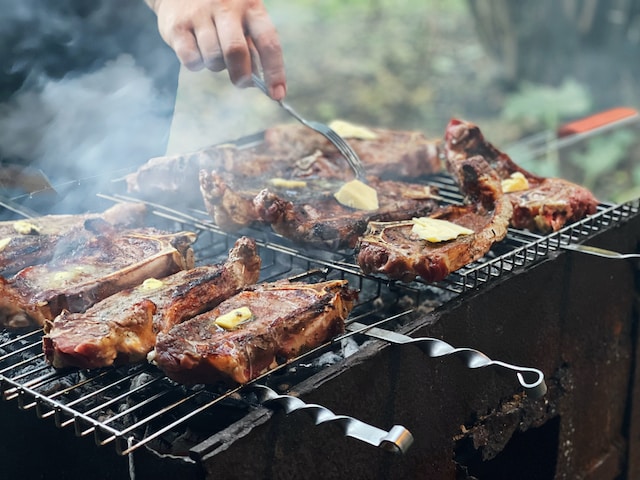
Smoke it: Use wood chips or pellets to achieve a smoky flavor. Different types of wood will add different flavors, such as hickory, mesquite, or applewood.
Marinate or dry rub: Marinating or using a dry rub can add flavor and tenderness to the meat.
Baste with sauce: Basting the meat with barbecue sauce adds flavor and moisture to the meat.
Resting the meat
Resting the meat is just as important as cooking it. Allowing the meat to rest for a few minutes after cooking will give the juices a chance to redistribute, resulting in a juicier and more flavorful end product.
Barbecue and grilling are more than just cooking techniques, they are a beloved tradition of American cuisine. From the tangy vinegar-based sauce of North Carolina to the sweet and smoky flavors of Memphis, each regional style of barbecue tells a story of cultural influence and culinary evolution. With a little practice and experimentation, anyone can become a master of the grill and create their own unique barbecue flavors. So fire up that grill, grab some high-quality meat, and get ready to enjoy the delicious, mouth-watering flavors of barbecue.
